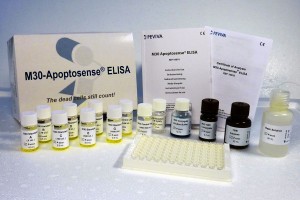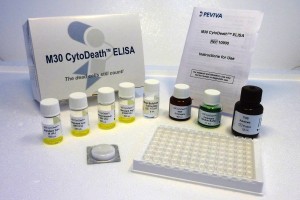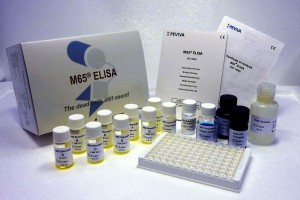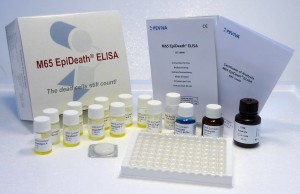Cell death is the biological process in which cells stop functioning due to the natural process of old cells dying and being replaced by new ones, or through disease, injury, or the death of the organism.
Once a point-of-no-return phase occurs, cell death ensues. Cell death is often classified based on morphological characteristics, enzyme activations, functional aspects, or by immunological characteristics. Therefore, multiple cell death categories have been described. The most commonly recognized modes of cell death are apoptosis and necrosis.
During apoptosis, keratin filaments are altered and remarkably stable keratin fragments are generated. Activation of caspases leads to proteolysis of numerous cellular proteins, including structural components of epithelial cells. K18 (also referred to in the literature as CK18) along with Keratin 8 are the major components of intermediate filaments in simple epithelial cells, and the only keratin pair in normal hepatocytes. During apoptosis, K8/K18 fragments are dramatically reorganized and K18 is cleaved by caspases at multiple sequence sites. Cleavage of K18 is an early event occurring during apoptosis. The M30 antibody recognizes a neo-epitope exposed after caspase cleavage of K18 after the aspartic acid residue 396. Cleavage at this position occurs early during apoptosis by caspase 9 and during the execution phase by caspase 3 and caspase 7.
Development of the M30 antibody into an ELISA represented the first research tool to measure a specific apoptosis product in the blood. The M30 Apoptosense® ELISA measures the levels of soluble ccK18 fragments containing the K18Asp396 neo-epitope. After induction of apoptosis in epithelial tissues, ccK18 increases are observed in the blood. Caspase-cleaved K18 fragments are remarkably stable in human serum, further adding to convenience and the easy to use method of this ELISA.
Cell Death Assays (For Research Use Only)
The PEVIVA product line is specialized in production and development of high end in vitro research biomarkers and antibody assays for the quantification of the cell death modes apoptosis and necrosis in epithelial, keratin 18 positive cells. Our products are used for research in the fields of hepatology, oncology and toxicology.
| Product | Cell cultures | Spheriods | Xenografts | Blood samples | Apoptosis | Total cell death | Ratio cell death mode |
|---|---|---|---|---|---|---|---|
| M30 Apoptosense® ELISA | X | X | X | X | X | X* | |
| M30 CytoDeath™ ELISA | X | X | X | ||||
| M65® ELISA | X | X | X | X | X | X* | |
| M65 EpiDeath® ELISA | X | X | X | X | X |
PEVIVA’s ELISA assay features:
- Apoptosis and / or necrosis specific
- Ready-to-use-format makes them very user friendly
- The kits are stable from 9 months up to 2 years
- They can be split up for multiple uses
- The kits are externally validated
- … and they are cost effective
Our products can be used with: cell cultures, spheroids, xenografts and blood samples. One can measure apoptosis, total cell death and the ratio between apoptosis and necrosis.
Apoptosis Assays
Apoptosis is the major cell death pathway for removing unnecessary cells during embryonic development, tissue homeostasis and immune regulation. The process of apoptosis leads from initiation via internal changes to blebbing, apoptotic bodies and finally secondary necrosis of these apoptotic bodies. Most anticancer therapies rely on the activation of apoptotic pathways and various assays are available for assessing drug-induced apoptosis.
These assays can be used in research of apoptosis related biochemical events, mainly A) caspase activation; B) membrane alterations; C) DNA fragmentation; D) release of cytochrome C from mitochondria (mitochondrial changes). Not all of these biochemical events are highly specific to apoptosis, and not all events occur in all stages of apoptosis (fast or late apoptosis). Therefore, it is critical to choose the biochemical events and corresponding assays wisely to be certain that tumor cell death occurs exclusively by this pathway. For example, if the measurement is based on the fact that a specific protein (e.g. Annexin V) cannot pass the membrane during apoptosis, this passage will occur later, when the apoptotic bodies die by secondary necrosis. Therefore, the Annexin V assay measurement is just a snapshot of the distribution between living, apoptotic and (secondary) necrotic cells/bodies. Chosen a late timepoint, all apoptotic cells will have passed on and are stained during secondary necrosis. A measurement at a single late time point will show no difference between cells that die by acute or secondary necrosis.
Like Annexin V, many methods cannot be regarded as integrative measures of apoptosis; they reflect the ongoing apoptotic process at a specific timepoint. Given fast apoptosis induction, the measurement at a single specific timepoint is a snapshot and will return a misleading value with these assays. Multiple measurements (thus establishing the kinetics) are therefore required. In contrast, when a test measures a stable apoptosis-specific product, measurements can be done hours to days after induction of apoptosis, and independent of the kinetics.
Finally, many of these research assays use low throughput and/or qualitative (QL) methods such as western blotting, microscopy or flow cytometry. Low throughput, QL methods, kinetic measurements and doubts about apoptosis specificity are all highly undesirable characteristics for anticancer drug screening.
We here present an alternative to above apoptosis assays that is based on the quantification of a product of caspase activation, a cornerstone of the apoptotic process. This method measures the caspase cleaved CK18 (ccCK18), which only is present if the cell has undergone the apoptotic process of internal protein cleavage (see also 3.2), independent of secondary necrotis. Moreover, the presence of ccCK18 is independent of the course and duration of the apoptosis process.
The Table below summarizes the characteristics for commonly used assays for apoptosis. Measuring ccCK18 in the drug development process meets all critical criteria: the results are apoptosis-specific, integrative, quantitative, and the ELISA method is high throughput and suitable for automation.
| Assay | Method | Measures (RUO) | Specificity | High/Low Throughput | QT/QL1 | Integrative Measure2 |
|---|---|---|---|---|---|---|
| Caspase Activation | ||||||
| ccCK18 | ELISA | M30 neoepitope of caspase-cleaved CK18 (ccCK18) | Highly specific for epithelial apoptosis, only cleaved fragment is detected | H | QT | Yes |
| CK18 | ELISA | Total and caspase-cleaved CK18 | Total epithelial cell death (necrosis + apoptosis) | H | QT | Yes |
| Antibodies against caspase cleaved substrates | Western blot, Immuno-precipitation, immune-histology | PARP-1 intact (113 kDa) & caspase cleaved fragment (89 kDa) | Specific for apoptosis, but subjective as non cleaved PARP is also detected | L | QL | No |
| Immuno-fluorescence, flow cytometry, fluorescence/ light microscopy | Caspase-cleaved CK18 (using M30 CytoDEATH™ monoclonal antibody) | Highly specific for epithelial apoptosis, only cleaved fragment is detected | L | sQT | Yes | |
| Activation of caspases | Immunoblot IHC Immuno-fluorescence | Cleaved (and thus activated) pro-caspases | Specific for apoptosis | L | QT | No |
| Caspase activity | Caspase enzyme assay | Quantitative detection of caspase activity in cellular lysates | Apoptosis specific | H | QT | No |
| Membrane alteration | ||||||
| Annexin V | Flow cytometry, Fluorescence or light microscopy | Translocation of PS to the outer cell membrane. Double staining with membrane- impermeable DNA dyes such as PI. Healthy cells are doubly negative to annexin V and PI, whereas cells in the early pha- ses of apoptosis are annexin-V-positive but PI-negative, and necrotic + secondary necrotic cells are double positive. | Apoptosis specific, but interpretation of results is subjective | L | sQT | No |
| LDH release | ELISA | Quantitation of LDH activity released from damaged/dying cells | Not specific for apoptosis | H | QT | Yes |
| DNA fragmentation | ||||||
| DNA ladder | Gel electro-phoresis | Apoptotic cells show a characteristic DNA ladder due to internucleosomal DNA degradation (multiples of 180 base pairs in size), while necrotic cells reveal a smear of randomly degraded DNA | 180 bp fragments are specific for apoptosis | L | QL | Yes |
| Hypodiploid DNA | Flow cytometry | Hypodiploid nuclei from apoptotic cells | Not fully specific for apoptosis | L | QL | No |
| Cytoplasmic nucleosomes | ELISA (Cell Death Detection plus) | Determination of nucleosomes in the cytoplasmic fraction of cell lysates. Not specific for the 180 bp apoptotic DNA fragments. | Not specific for apoptosis, Nucleosome- like DNA fragments can also result from other types of cell death [3] | H | QT | No |
| TUNEL | Light/ fluorescence microscopy or flow cytometry | Endonuclease-generated DNA breaks are enzymatically labelled by terminal transferase with UTP derivatives coupled to fluorochromes or biotin. | Not fully specific for apoptosis | L | sQT | No |
| Mitochondrial changes | ||||||
| MPT | Flow cytometry or Fluorescence Microscopy | Loss of the inner mitochondrial transmembrane potential, causing a pore. | Not specific for apoptosis, MT damage may occur in late apoptosis, but also during necrosis | L | QL/ sQT | No |
| Cytochrome C | Immuno-cytochemistry High Content Analysis Immuno-fluorescence | Release of Cytochrome C from the intermembrane space into the cytosol | Not specific for apoptosis | L | QL/ sQT | No |
PS: phospholipid phosphatidylserine; PI: propidium iodide; PARP-1: poly ADP-ribose polymerase; TUNEL: terminal dUTP nick end-labeling; MPT: mitochondrial permeability transition; LDH: lactate dehydrogenase 1) QL: qualitative; QT: quantitative; sQT: semi-quantitative; 2) Integrative measure is a test measuring a stable product, measurements can be done hours to days after induction of apoptosis
- Presentation: Peviva Oncology Cell Death Products Presentation (from basic research to disease modelling to clinical trials)
- Article: Measurement of Total Cytokeratin 18 (CK18) and Apoptosis-Specific Caspase Cleaved CK18 (ccCK18), as Specific Cell Death Markers in Anticancer Drug Development




M30 and M65 are for research use only in the US and Canada